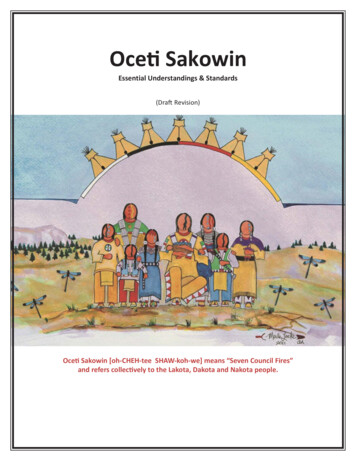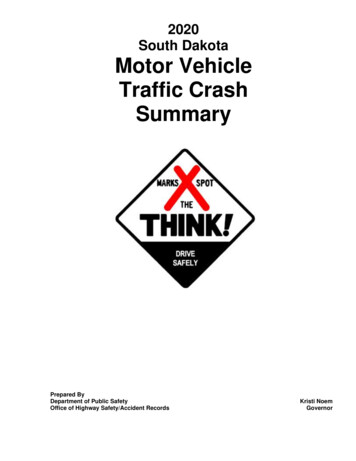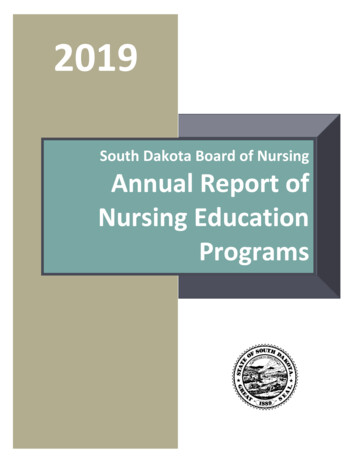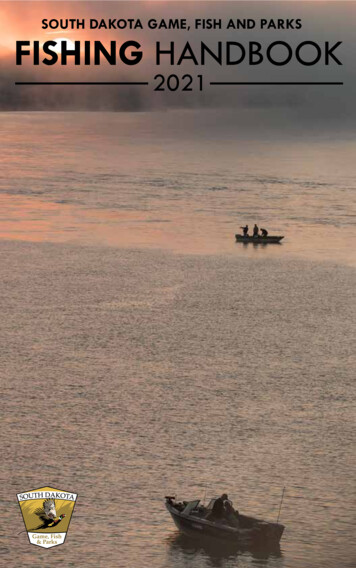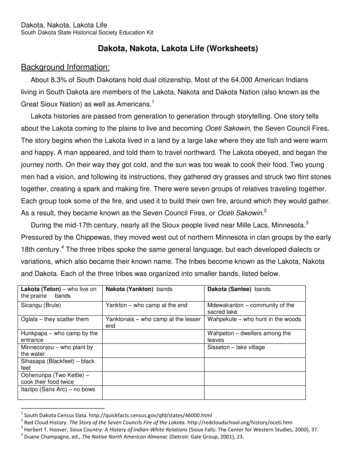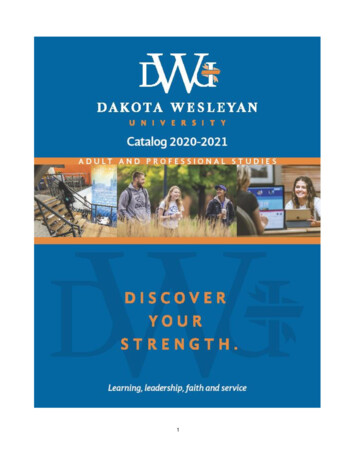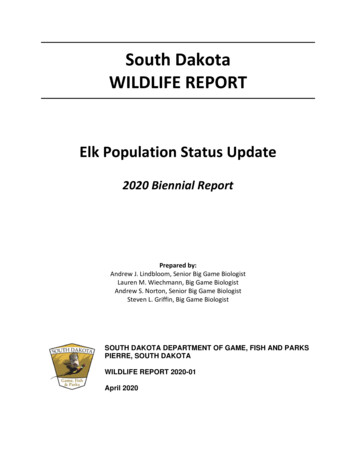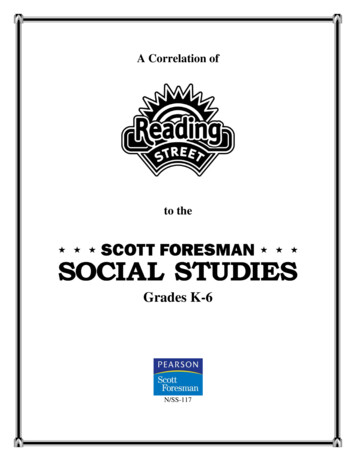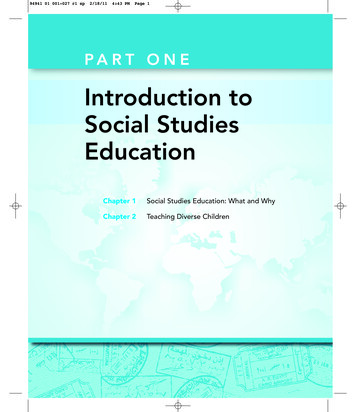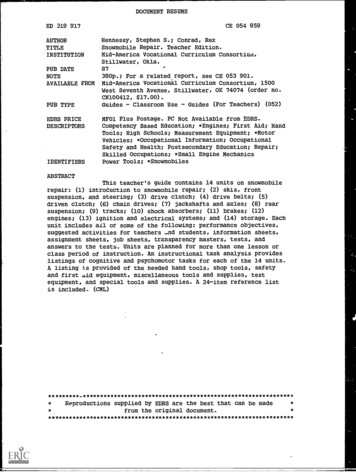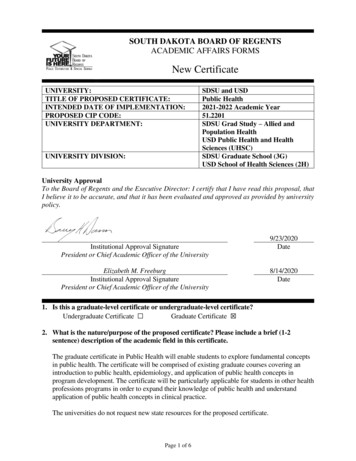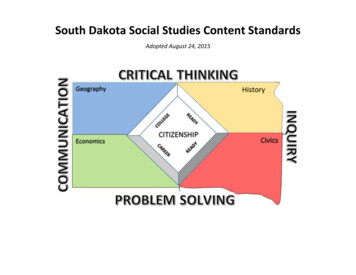
Transcription
South Dakota Social Studies Content StandardsAdopted August 24, 2015
AcknowledgmentsThe revised Social Studies Content Standards are a result of the contributions of educators from across the state. Many hours were devoted to research andthoughtful consideration of issues to ensure that the standards would reflect rigorous social studies teaching and provide opportunities for students to learnimportant social studies concepts, facts, and processes. The Social Studies Content Standards Revision Committee members represent concerned individualsacross the state dedicated to their profession and to high-quality social studies education. Without their contributions, the revision of the Social Studies ContentStandards would not have been possible. The South Dakota Department of Education wishes to express appreciation and gratitude to the individuals and theorganizations they represent who contributed expertise and time to the revision of South Dakota’s Social Studies Content Standards.South Dakota Social Studies Content Standards Revision Committee Members 2014NameSchool District/AffiliationTitleBagley, RobinChiesman Center for DemocracyDirector of Civic EducationBelfrage, MartaSioux Falls Public Schools - Memorial MS8th Grade U.S. historyBell, EricaSioux Falls Public Schools - Edison Middle8th Grade American historyBohl, JoanneWest Central School DistrictWorld History, Government, EconomicsBolstad, TylerBrookings School District5th Grade TeacherBrink, MarquetteSt.Joseph School - Pierre5th Grade TeacherCass, PatrickMeade School District8th Grade U.S. HistoryClercx, JustinElk Point-Jefferson School DistrictMS Social Studies TeacherCrown, SandyHermosa (Custer School District)1st Grade TeacherDavis, MicheleTechnology and Innovation in EducationLearning SpecialistGarrett, MeganRapid City Public SchoolsMiddle School Social StudiesGholson, SeanDouglas School District9-12 Social Studies TeacherGritzner, Dr. CharlesSouth Dakota State UniversityDistinguished Professor EmeritusGuse, ScottSioux Falls School District, Washington HSAP PsychologyHaffner-Baumeister, Kristie McIntosh School District8-12 Social Studies TeacherHarder-Huwe, NancyMS Social StudiesRapid City Area Schools2
Harming, CherylElkton School District7-12 Social StudiesHawkins, GeorgeSioux Falls New Technology High SchoolU.S. History, Government, AP Government FacilitatorIverson, ErikRapid City Area Schools/BHSU Adjunct9-12 U.SS HistoryKarstens, JustinGayville-Volin School District9-12 Social Studies TeacherKrahenbuhl, Dr. KevinDakota State UniversityAssistant Professor in the College of EducationLacher, CarolIpswich School District5th Grade TeacherLarsen, TraceySioux Falls School District, Patrick Henry MS 8th Grade U.S. History TeacherLein, KevinHarrisburg School DistrictHigh School PrincipalLong, AmyYankton School District8th Grade U.S. History TeacherMay, Mary JoRapid City Area SchoolsWorld History, Native American Heritage, Sociology, & Civics TeacherNelin-Maruani, MichelleRapid City Area SchoolsSocial Science CoordinatorNystrom, MarthaPierre School District, Middle School6th Grade Social StudiesOlson, LaurenRutland School DistrictHigh School Social StudiesPlowman, LauraBrookings School DistrictWorld History, U.S. History, and AP U.S. Government teacherRenner, BethBritton-Hecla School DistrictElementary TeacherSchlosser, BrandiIpswich School DistrictElementary TeacherShaw, SamDepartment of EducationDivision of Learning and InstructionToft, EricBrookings7th Grade Geography TeacherVroman, BethSioux Falls School District, Patrick Henry MS 7th Grade Geography Teacher3
Social Studies OverviewPrefaceThese Social Studies Content Standards are set forth to ensure graduates of South Dakota’s public schools have the knowledge, skills, and competenciesessential to leading productive, fulfilling, and successful lives as they continue their education, enter the workforce, and assume their civic responsibilities.The final document evolved from recent research in best practices in teaching, adoption of rigorous content standards in other core subjects, experience inclassrooms with the existing South Dakota Content Standards, the advancement of published standards from other states, the National Curriculum Standards forSocial Studies, United States history, geography, civics, and economics, numerous professional publications, and lengthy discussions by experienced kindergartenthrough post-secondary South Dakota educators.The outcomes students are expected to attain at each grade level are stated explicitly in these standards. With student mastery of this content, South Dakotaschools will be competitive with the best educational systems in other states and nations. The standards are comprehensive and specific, they are rigorous, andthey represent South Dakota’s commitment to excellence. The standards are firm but not unyielding; they will be modified in future years to reflect newresearch and scholarship.Purpose and Key ConsiderationsPerhaps more than any other discipline, the social studies can provide students an opportunity to grow as independent decision-makers. This provides thefoundation for pedagogy and instructional strategies. The standards in this document must be considered a vehicle to achieve greater educational goals. Thestandards are developmentally appropriate and logically sequenced for use as a framework to assist student growth in the following skills:1. Responsible citizenship found in the Civics/Government standards.2. Spatial awareness found in the Geography standards.3. Economic literacy found in the Economics standards.4. Historical analysis found in the History standards.The South Dakota Social Studies Content Standards provide a listing of essential core content to be taught and learned. The standards are designed to guide theplanning of instruction and to anchor the assessment of learning from kindergarten through twelfth grade. Outcomes are meant to inform content standards,assessment, provide information to teachers and students regarding student progress toward mastery of the standards, and specify targets for instruction andlearning. The document presents a starting point for informed dialogue among those dedicated and committed to quality education in South Dakota. Byproviding a common set of goals and expectations for all students in all schools, this dialogue will be strengthened and enhanced.4
Teachers can use the above skills to evaluate instruction and student performance. Curricular construction should make use of the above skills to guidecurricular decisions. The standards in this document provide a roadmap to avoid redundancy except when necessary and to supply consistency across the state.Teachers, however, are not restricted to only the content represented. The depth and breadth of the social studies should provide teachers endless possibilitiesto create enlivened lessons that foster student advancement in social studies skills. Teachers are encouraged to measure instructional success by studentadvancement and not the amount of material covered or the quantity memorized. The following standards can guide the content selection to promote studentachievement, but are not intended to limit instructional innovation. The social studies teacher aspires to provide instruction in the standards throughmeaningful, challenging, integrated, and active lessons. The standards support teachers in this quest. The foundation of these state standards is designed tofoster responsible decision making that benefits the local and tribal community, state, nation, and world. Responsible citizens are informed, active, andrecognize their connection with the world. The Social Studies Content Standards are organized into four disciplines: History, Geography, Civics/Government, andEconomics. Each discipline is addressed at appropriate grade levels with increasing rigor and relevance.As students move from kindergarten through grade 12, levels of cognitive demand and complexity of content, skills, and processes increase. New skills emergeand basic skills are subsumed within more advanced skills as students progress through the grades. Grade-level outcomes specify what students should knowand be able to do by the end of each grade level. Because standards are not curriculum, any necessary review embedded in curriculum does not appear fromgrade-to-grade across grade-level standards. Teachers are charged with introducing skills in earlier grades before mastery is expected and with reviewing skillsstudents will need to use in mastering the grade-level standards.Notable Changes (from 2007 SS Standards document to the 2014 SS Standards document) Unified standards K-12 in all disciplinesUsed the terms "Anchor Standards" and "Grade-level Standards" to indicate larger goals and their subsequent grade level aim.Moved World and U.S. History under the discipline HistoryUsed C3 Framework skills and parallel South Dakota Literacy for History/Social Studies in Reading and Writing Standards to inform standards andoutcomesCreated skill-based, content standards including college, career, and civic readiness thinking skills: inquiry, communication, critical thinking, and problemsolvingIntegrated Webb Leveling /DOK (Depth of Knowledge)Removed “Core” and “Advanced” distinctionsRemoved specific curriculum examples from within the standardsRemoved enabling skills and ensured they were embedded in content standardsWrote HS Economics for stand-alone Economics course compared to the 2007 document, which had HS Economics standards cross-referenced toanother disciplineIncluded standards for how humans culturally adapt to their environment in the K-2 Geography standardsSD History now spans 3-5th grade, leaving the majority of the SD History outcomes in 4th grade and also ensuring the content is built upon in a learningprogressionIncluded standards for US History in grades 9-12 that cover from the Revolution to Reconstruction.5
Organization of the South Dakota K-12 Social Studies Content Standards DocumentGuide to the Number and Symbol SystemThe South Dakota K-12 Social Studies Content Standards include both K-12 anchor standards and grade-level standards (what students should know and be ableto do) each grade level (K-8) or grade band (9-12).The Anchor Standards are coded to show Grade Level/Grade Band, Discipline, and Anchor Standard only. Anchor Standards are the same for all grades K12 and ensure that vertical progression occurs as students proceed from one grade to the next.The Grade Level Standards are coded to show Grade Level/Grade Band, Discipline, Anchor Standard, and the Grade Level Standard (see example codebelow). Grade Level Standards are specific outcomes for the respective grade level or grade band.Grade Level Standard Example9-12.G.1.1Grade LevelDisciplineAnchor StandardGrade LevelStandardExample: 9-12.G.1.1 (9th through 12th grade, Geography, Anchor Standard 1, Grade Level Standard 1)6
Additional ResourcesSince this document uses appropriate social studies terminology, a reader may occasionally encounter an unfamiliar term. In order to assist the reader withterminology used in this document, a glossary has been included with specific definitions to clarify intended meaning by discipline. In addition, a comprehensiveglossary is provided as a sampling of possible information sources. Because new resources are constantly becoming available, this list is intended to be neitherexhaustive nor required.South Dakota used research-based resources to inform the newest SD standards. Starting in June 2014, the workgroup reviewed the C3 Framework – a skill setneeded for students to be College, Career, and Civic ready. In June the workgroup began by utilizing the expertise of the writers of C3 Framework, reviewed thecurrent SD Standards, and discussed how the framework and the current SD Content Standards could inform the next draft of the SD State SS Standards. Thefinal South Dakota product is an amalgamation that was created from documents based in research, national association’s contributions, existing South DakotaSocial Studies Standards, the C3 Framework, and the National Curriculum Standards for Social Studies. The following are the resources/associations that hadbeen referred to at some point throughout the standards revision process:American Bar AssociationAmerican Geographical SocietyAmerican Historical AssociationAssociation of American GeographersC3 FrameworkCampaign for the Civic Mission of SchoolsCenter for Civic EducationConstitutional Rights Foundation ChicagoConstitutional Rights Foundation USACouncil for Economic EducationNational Council for Geographic EducationNational Council for History EducationNational Council for the Social StudiesNational Geographic SocietyNational History DayStreet Law, Inc.The College BoardWorld History Association7
General Introduction to C3 FrameworkThe C3 Framework served as inspiration for the graphic designed by the Social Studies Workgroup and it is intended to give a visual representation of theoverarching themes within this standards document. The C3 Framework is split into four Dimensions: (1) Developing questions and planning inquiries; (2)applying disciplinary concepts and tools; (3) evaluating sources and using evidence; and (4) communicating conclusions and taking informed action.C3 Integration & Parallels to the Visual on the Title PageThe South Dakota Social Studies Graphic utilizes elements from each of these Dimensions justas our standards documents sought to connect the C3 skills into our state standards. Along theright-hand side of the image is “inquiry” and it directly correlates with Dimension 1 of the C3Framework, which is “developing questions and planning inquiries.” On the left-hand side is“communication”, which parallels with Dimension 4 of the C3 Framework: “communicatingconclusions and taking informed action”. Finally, the four colored quadrants of the SouthDakota layout reflect the four sub-elements of Dimension 2 “applying disciplinary concepts andtools” and includes specified history, geography, civics, and economics concepts and tools.Thus, this visual was adopted as a graphical representation of the parallels between the C3Framework representing our commitment to increasing skill development and rigor inconjunction within the core disciplines of the social studies.8
A Message to Teachers, Principals, Superintendents, and Others Who Will Use the DocumentThe Social Studies Content Standards Revision Committee was made up of a group of kindergarten through post-secondary educators who collaborated toestablish a starting point for reaching South Dakota’s goal: each student graduates prepared for college, career, and civic life.A set of standards is simply a place to begin—it lays the foundation for measurable, consistent, high-level student learning. Teachers, however, have theflexibility to consider the needs of their individual students and select the methods that will work best for their classrooms. Clearly, there is more to teaching andlearning than these standards. The standards are a starting point in creating an environment where students can learn to live and thrive in a constantly changing,increasingly complex world.ConclusionThe committee provides, through the standards document, a framework for the teaching and learning of social studies content, concepts, and skills. Thecommittee members wish to emphasize, however, that the real goal of social studies teachers is to inspire students to become committed, participatingcitizens. This requires that students develop skills and dispositions that are difficult to assess. Teachers who accomplish this goal with students practice the artand science of teaching. They are professionals who prioritize content that leads to citizenship skill development, often beyond the achievement of the statedSocial Studies Content Standards, rather than teaching simply to “cover” the material. Social Studies is so much more than facts, places, and dates; it is thesingular discipline that enables students to obtain a rich and broad understanding of the complex world they inhabit. We believe that civic virtues are embeddedwithin the standards, but are not specifically addressed due to the inability to measure them, i.e., volunteerism, honesty, loyalty. We are confident that teacherswill emphasize the importance of these vital components of social studies teaching and learning.Kindergarten .page 101st Grade .page 122nd Grade .page 143rd Grade .page 164th Grade .page 185th Grade .page 216th Grade .page 25Table of Contents for the Grade Band/Grade Level Standards7th Grade .page 278th Grade .page 299-12 Civics/Government page 339-12 Geography .page 359-12 Economics .page 369-12 U.S. History .page 389-12 World History page 399
Anchor Standards and Grade Level/Band StandardsKindergartenKindergarten HistoryK-12.H.1 Students will analyze how major events are chronologically connected and evaluate their impact on one another.K.H.1.1Distinguish yesterday, today, and tomorrowK-12.H.2 Students will analyze and evaluate the impact of people, events, ideas, and symbols upon history using multiple sources.K.H.2.1Identify local and national celebrationsKindergarten Civics/GovernmentK-12.C.1 Students will explain, compare and contrast, and analyze the historical principles and philosophical purposes of various forms of governments.K.C.1.1Identify our country’s flag of the United States as a symbol of the nationK-12.C.2 Students will explain the historical impact of primary founding documents including, but not limited to, the Declaration of Independence, the U.S.Constitution, the U.S. Bill of Rights and subsequent amendments.K.C.2.1Understand classroom rules and why they are importantKindergarten GeographyK-12.G.1 Students will apply geospatial resources, including data sources and geographic tools to generate, interpret, and analyze information.K.G.1.1Recognize that maps and globes represent placesK.G.1.2Use environmental directions or positional words including but not limited to up, down, above, and below to identify significant locations in theclassroomK-12.G.3 Students will recognize the characteristics of the processes that shape places and regions.K.G.3.1Identify and describe places in the immediate environment including the classroom and/or playgroundK-12.G.6 Students will understand the ways in which humans culturally adapt to, use, and modify the natural environment and its various elements10
K.G.6.1Describe ways people rely on the environment to meet human needs and wantsKindergarten EconomicsK-12.E.1 Students will apply the fundamental economic ideas and concepts associated with the study of economics.K.E.1.1Describe the difference between wants and needs11
Grade 1Grade 1 HistoryK-12.H.1 Students will analyze how major events are chronologically connected and evaluate their impact on one another.1.H.1.1Demonstrate chronological order using events from their own lives1.H.1.2Describe ways people learn about the past including but not limited to photos, artifacts, stories, and videosK-12.H.2 Students will analyze and evaluate the impact of people, events, ideas and symbols upon history using multiple sources.1.H.2.1Connect people and events honored in commemorative celebrationsGrade 1 Civics/GovernmentK-12.C.1 Students will explain, compare and contrast, and analyze the historical principles and philosophical purposes of various forms of governments.1.C.1.1Identify primary symbols of the United StatesK-12.C.2 Students will explain the historical impact of primary founding documents including, but not limited to, the Declaration of Independence, the U.S.Constitution, the U.S. Bill of Rights and subsequent amendments.1.C.2.1Explain who makes decisions and rules in the schoolK-12.C.3 Students will explain how the Constitution organizes the government of the United States.1.C.3.1Identify services in your local community including but not limited to police, fire, and ambulanceGrade 1 GeographyK-12.G.1 Students will apply geospatial resources, including data sources and geographic tools to generate, interpret, and analyze information.1.G.1.1Construct simple maps of the classroom1.G.1.2Use maps, globes, and other simple geographic models to identify absolute location1.G.1.3Distinguish between landmasses and bodies of water using maps and globesK-12.G.3 Students will recognize the characteristics of the processes that shape places and regions.12
Describe the unifying characteristics and boundaries of different school regions including but not limited to the playground, classroom, andreading cornerK-12.G.6 Students will understand the ways in which humans culturally adapt to, use, and modify the natural environment and its various elements.1.G.3.11.G.6.1Describe ways in which people modify and adapt to the environmentGrade 1 EconomicsK-12.E.1 Students will apply the fundamental economic ideas and concepts associated with the study of economics.1.E.1.1Distinguish between goods and services and how families use them1.E.1.2Describe ways in which people earn money13
Grade 2Grade 2 HistoryK-12.H.1 Students will analyze how major events are chronologically connected and evaluate their impact on one another.2.H.1.1Demonstrate chronological order using events from history2.H.1.2Use historical records and artifacts including but not limited to photos, diaries, oral histories, and videos to draw conclusions about family orschool life in the pastK-12.H.2 Students will analyze and evaluate the impact of people, events, ideas and symbols upon history using multiple sources.2.H.2.1Compare how holidays are celebrated in different culturesGrade 2 Civics/GovernmentK-12.C.1 Students will explain, compare and contrast, and analyze the historical principles and philosophical purposes and various forms of governments.2.C.1.1Explain, in written form, through speech, or through the use of technology, the meaning behind our national symbolsK-12.C.2 Students will explain the historical impact of primary founding documents, including but not limited to, the Declaration of Independence, the U.S.Constitution, the U.S. Bill of Rights and subsequent amendments.2.C.2.1Explain the basic political roles of leaders in the larger communityK-12.C.3 Students will explain how the Constitution organizes the government of the United States.2.C.3.1Identify laws in your local government and how local laws are made2.C.3.2Identify how local government services are fundedGrade 2 GeographyK-12.G.1 Students will apply geospatial resources, including data sources and geographic tools to generate, interpret, and analyze information.2.G.1.1Construct and explain a map that includes directions, labels, and a key2.G.1.2Explain how local communities are part of a larger regionK-12.G.3 Students will recognize the characteristics of the processes that shape places and regions.14
2.G.3.1Compare the physical and man-made characteristics of the local community with those of another communityK-12.G.6 Students will understand the ways in which humans culturally adapt to, use, and modify the natural environment and its various elements.2.G.6.1Describe positive and negative consequences of changing the physical environment of the local community2.G.6.2Suggest ways people can responsibly interact with the environment in the local communityGrade 2 EconomicsK-12.E.1 Students will apply the fundamental economic ideas and concepts associated with the study of economics.2.E.1.1Identify goods and services available in the students’ communities15
Grade 3Grade 3 HistoryK-12.H.1 Students will analyze how major events are chronologically connected and evaluate their impact on one another.3.H.1.1Demonstrate knowledge of the obstacles and successes of the early settlers and in creating communities3.H.1.2Explain cause and effect relationships that impacted early settlement and development in the United StatesK-12.H.2 Students will analyze and evaluate the impact of people, events, ideas and symbols upon history using multiple sources.3.H.2.1Generate questions about individuals and groups who have shaped significant historical changes and continuities3.H.2.2Explain the importance of famous American figures including but not limited to George Washington, Abraham Lincoln, and Thomas Jefferson3.H.2.3Analyze a community’s culture and historyK-12.H.5 Students will develop historical research skills.3.H.5.1Compare information provided by different primary and secondary historical sources about the pastGrade 3 Civics/GovernmentK-12.C.1 Students will explain, compare and contrast, and analyze the historical principles and philosophical purposes and various forms of governments.3.C.1.1Research and explain the meaning behind South Dakota’s symbolsK-12.C.2 Students will explain the historical impact of primary founding documents including but not limited to, the Declaration of Independence, U.S.Constitution, the U.S. Bill of Rights and subsequent amendments.3.C.2.1Explain the meaning and importance of the Declaration of Independence and the Constitution3.C.2.2Explain the basic political roles of leaders in the state and nationK-12.C.3 Students will explain how the Constitution organizes the government of the United States.3.C.3.1Identify why laws and responsibilities are needed in a community and why there are legal consequences3.C.3.2Identify the structure, roles, and responsibility of local government16
K-12.C.4 Students will understand the fundamental principles of America’s democratic republic and the United States Constitution and the inherent conflictsthat may arise.3.C.4.1Explain the role of government agencies in a community3.C.4.2Explain why communities have rules and laws3.C.4.3Identify the rights and responsibilities of citizenship in students’ own communitiesGrade 3 GeographyK-12.G.1 Students will apply geospatial resources, including data sources and geographic tools to generate, interpret, and analyze information.3.G.1.1Identify locations in a community by using grid systems3.G.1.2Locate the seven continents, four oceans, and major physical features and regions of the United States on a map or globeK-12.G.2 Students will understand the nature and importance of the Five Themes of Geography: location, place characteristics, human-environmentinteraction, movement, and region.3.G.2.1Identify reasons why people move and how it affects their communitiesGrade 3 EconomicsK-12.E.1 Students will apply the fundamental economic ideas and concepts associated with the study of economics.3.E.1.1Explain ways producers use resources to produce goods and servicesK-12.E.5 Students will describe how trade generates economic development and interdependence.3.E.5.1Use examples to show that people in modern society may not be able to produce everything they want and depend upon trade with others tomeet their wants17
Grade 4Grade 4 HistoryK-12.H.1 Students will analyze how major events are chronologically connected and evaluate their impact on one another.4.H.1.1Analyze the impact of significant historical events on the development of cultures in South Dakota4.H.1.2Generate questions about multiple historical sources and their relationships to particular historical events and developmentsK-12.H.2 Students will analyze and evaluate the impact of people, events, ideas and symbols upon history using multiple sources.4.H.2.1Explain the effects of conflicts and the establishment of reservations on the American Indians culture4.H.2.2Examine basic environmental, economic, cultural, and population issues of concern to South Dakota4.H.2.3Describe the influence of notable South Dakotans of the development of our state4.H.2.4Describe influences of European cultures on South Dakota communities4.H.2.5Describe how wars affected South DakotansK-12.H.3 Students will analyze and evaluate historical events from multiple perspectives.4.H.3.1Compare and contrast life today with life in historical time periodsK-12.H.4 Students will identify and evaluate the causes and effects of past, current and potential events, issues and problems.4.H.4.1Explain probable causes and effects of events and developments in South Dakota4.H.4.2Explain factors affecting the growth and expansion of South DakotaK-12.H.5 Students will develop historical research skills.4.H.5.1Infer the intended audience and purpose of a historical source from information within the source itself4.H.5.2Use evidence to develop a claim about the past18
Grade 4 Civics/GovernmentK-12.C.1 Students will explain, compare and contrast, and analyze the historical principles and philosophical purposes and various forms of governments.4.C.1.1Describe key events related to South Dakota’s entry into statehoodK-12.C.2 Students will explain the historical impact of primary founding documents including but not limited to, the Declaration of Independence, the U.S.Constitution, the U.S. Bill of Rights and subsequent amendments.4.C.2.1Compare and contrast major themes within the SD Constitution and the U.S. ConstitutionK-12.C.3 Students will explain how the Constitution organizes the government of the United States.4.C.3.1Explain how groups of people make rules to create responsibilities and protect freedoms4.C.3.2Discuss South Dakota’s government and the roles of the three branchesGrade 4 GeographyK-12.G.1 Students will apply geospatial resources, including data sources and geographic tools to generate, interpret, and analyze information.4.G.1.1Locate major political and physical features of South Dakota and the United States on a map or globeK-12.G.2 Students will understand the nature and importance of the Five Themes of Geography: location, place characteristics, human-environmentinteraction, movement, and region.4.G.2.1Compare and contrast regions of South Dakota to one anotherK-12.G.3 Students will
Plowman, Laura Brookings School District World History, U.S. History, and AP U.S. Government teacher Renner, Beth Britton-Hecla School District Elementary Teacher . Social Studies Standards, the C3 Framework, and the National Curriculum Standards for Social Studi
